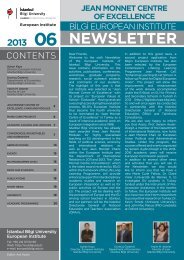WP2 Turkey: Country Report - İstanbul Bilgi Üniversitesi | AB Enstitüsü
WP2 Turkey: Country Report - İstanbul Bilgi Üniversitesi | AB Enstitüsü
WP2 Turkey: Country Report - İstanbul Bilgi Üniversitesi | AB Enstitüsü
You also want an ePaper? Increase the reach of your titles
YUMPU automatically turns print PDFs into web optimized ePapers that Google loves.
Social Impact of Emigration and Rural-Urban Migration in Central and Eastern Europe<br />
VT/2010/001<br />
among women and has been decreasing over time. This development is related to migration<br />
because work opportunities are more available in rural locations for women. Cultural reasons<br />
do also create a barrier against labour force participation of women in urban areas (note that<br />
although the rate for men is 70.8% in 2010 (close to the European level of 77.6%), it goes<br />
down to 27.6% for women. Ongoing rural-urban migration and subsequent low education<br />
(skill) levels in urban labour markets (Dayıoğlu and Ercan, 2011) are distinguishing the<br />
labour market features of <strong>Turkey</strong> from the EU’s Mediterranean countries. The median<br />
education level is primary school (five years) in <strong>Turkey</strong>. For pertinent labour market indicator<br />
comparisons with the OECD countries, one is advised to use non-agricultural labour market<br />
rates. Otherwise, labour force participation and employment rates look “better”, although<br />
these better versions are also very low relative to the EU averages. Turkish labour force<br />
participation rate (LFPR) is 49% and the employment rate is 43% (2010, Figure 4).<br />
Unemployment statistics before 1988 are controversial at best, based on a few questions<br />
asked in general census or non-standard ones in Labor Force Surveys. It was only after<br />
1988 that reliable standard statistics were developed (see Bulutay 1995). Hansen (1989)<br />
analyzes official labor force statistics for the period and argues that unemployment level has<br />
been relatively low, in contrast with official estimates, until the second half of the 1970s.<br />
Considering controversial nature of these statistics we refrain here from relating those to<br />
migration.<br />
Along with Istanbul, central east Anatolia has the highest unemployment rate in <strong>Turkey</strong> at<br />
14.3% (2010). This is a case in point for the agricultural softening of labour market statistics.<br />
While agricultural and non-agricultural unemployment rates are the same in Istanbul, central<br />
east Anatolia has the highest non-agricultural unemployment rate in <strong>Turkey</strong> at 21.7%<br />
followed by the Mediterranean region (18.1%). The eastern Mediterranean cities of Adana<br />
and Mersin receive a great deal of migration from the east and the southeast of <strong>Turkey</strong>. The<br />
Western Marmara and Western Anatolia regions have lower non-agricultural unemployment<br />
rates (11.8% and 12.3%, respectively) than the national average of 14.8%.<br />
The eastern Black Sea region has the highest LFPR (58.2%) and the lowest unemployment<br />
rate (6.1%) in <strong>Turkey</strong>, along with the neighbouring Northeastern Anatolia (TRA) at 8.2%.<br />
These almost represent robust European values. It is also important to consider agriculture’s<br />
influence (hazelnut, kiwi, and tea) because women are unpaid family workers. The region’s<br />
non-agricultural unemployment rate is 12.5%. Along with Southeastern Anatolia (TRC), these<br />
two regions are the proportionately largest out-migration regions. Southeastern Anatolia has<br />
the lowest LFPR in <strong>Turkey</strong> at 38%. Its employment rate is also the lowest at 33%, followed<br />
by its neighbour to the north, central east Anatolia (TRB) at 39%. Unlike the eastern Black<br />
Sea region, this arid region does not have much agricultural activity and consequently<br />
women simply do not exist in the labour force (Dayioglu and Ercan, 2011).<br />
Although these proportions paint a bleak picture of <strong>Turkey</strong>’s east, three NUTS1 regions of<br />
eastern Black Sea and eastern Anatolia (Map 1) are the least populated regions. Their<br />
combined working age population of 5.6 million is less than the single regional values of<br />
Istanbul, Aegean, and the Mediterranean. With ongoing westerly migration, one may design<br />
suitable education and labour market policies to tackle the employability problem. As such,<br />
Italian experience to be discussed in this Peer Review could be instructive. Finally it is<br />
important to note, that Central Anatolia, where Ankara dominates, has the second lowest<br />
LFPR in <strong>Turkey</strong> at 45%, which is below the national rate of 49%. However, Ankara has<br />
insignificant agricultural employment, and despite the existence of Konya province in the<br />
same region, which is the breadbasket of <strong>Turkey</strong>, most of the labour force in the region is in<br />
industry and services.<br />
Apart from the impact on labour market, migration has also affected the economy through<br />
remittances. As touched upon above, remittances as the earnings generated and sent back<br />
home by the migrant workers, have been an important source of revenue for developing<br />
countries. The case of <strong>Turkey</strong> shows no exception to this trend in the trajectory of<br />
remittances since the 1960s. Especially in the 1960s, the remittances were regarded as the<br />
major source of external financing catering for offsetting the trade deficits in particular. Figure<br />
Final <strong>Country</strong> <strong>Report</strong> <strong>Turkey</strong> 10



